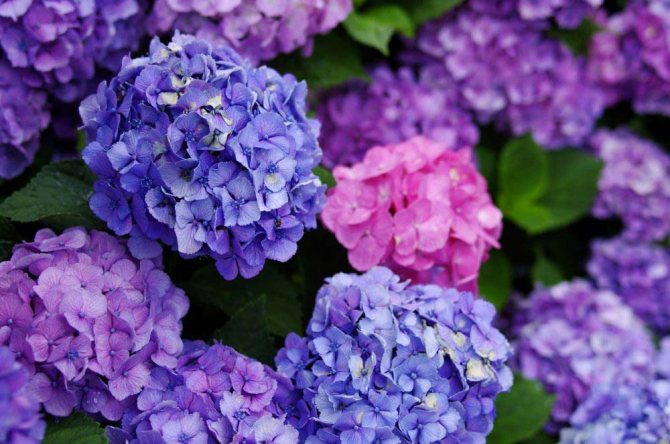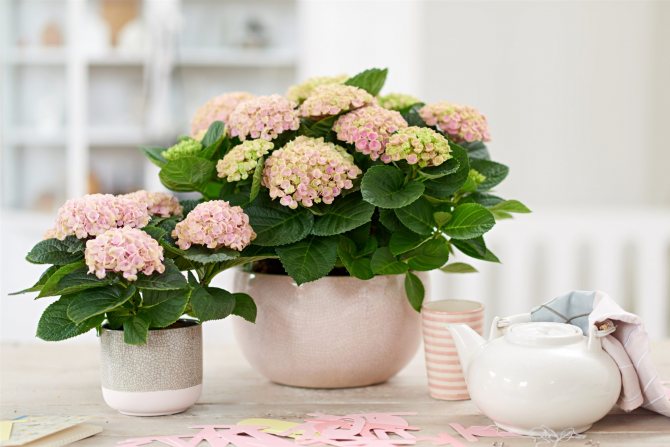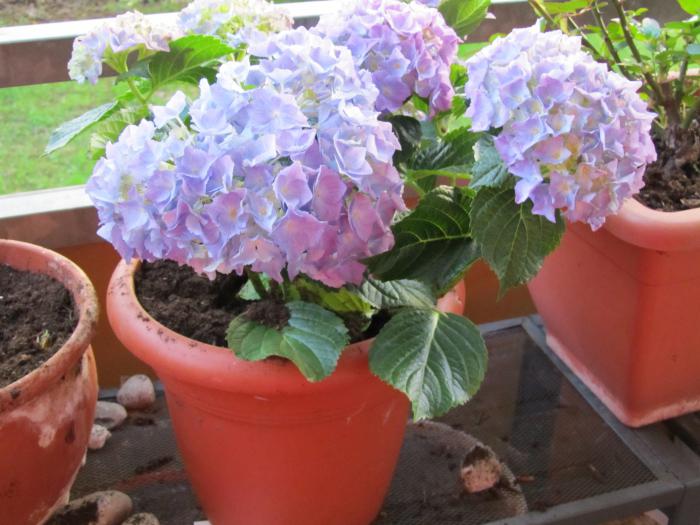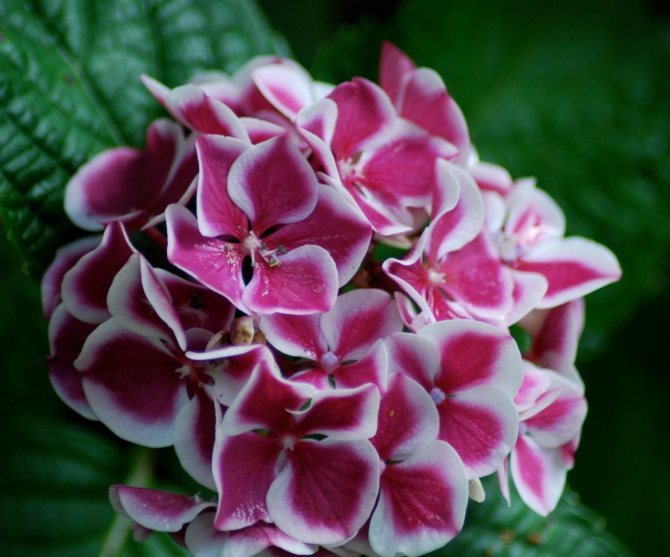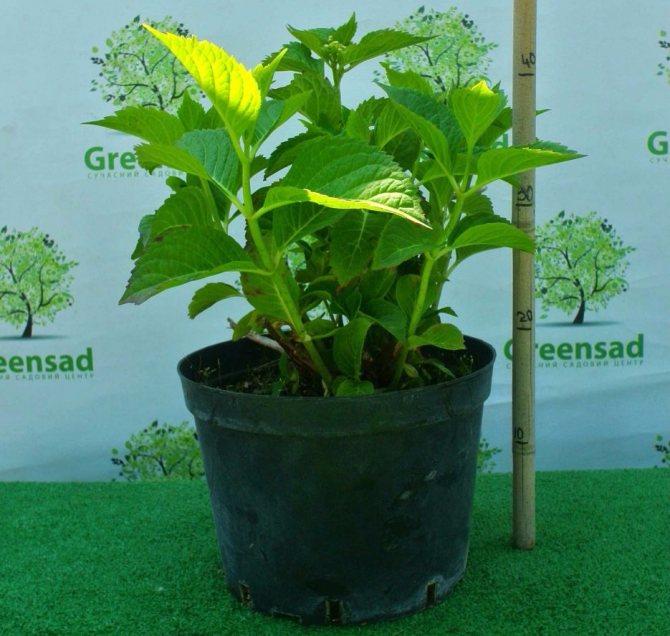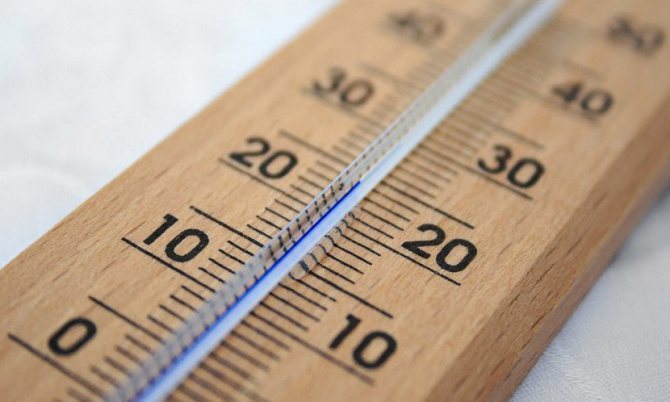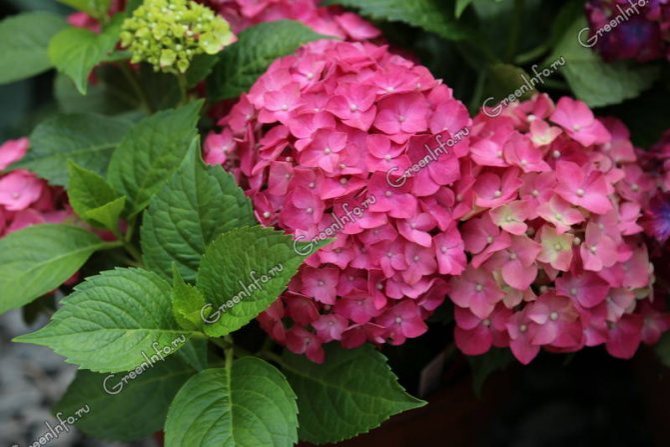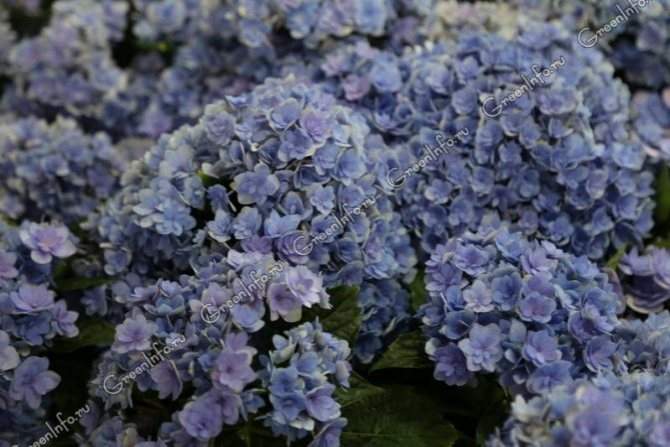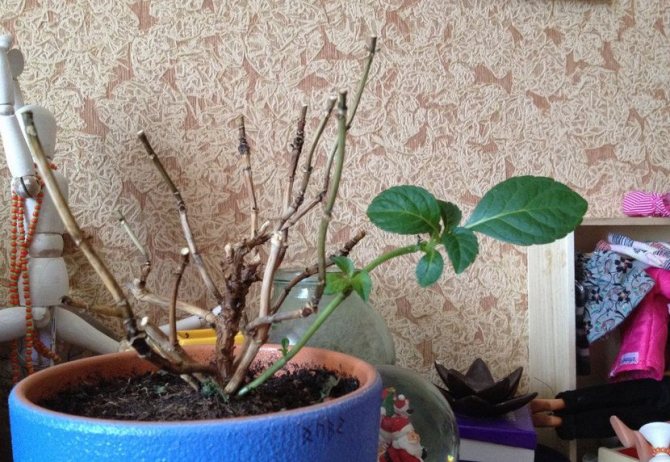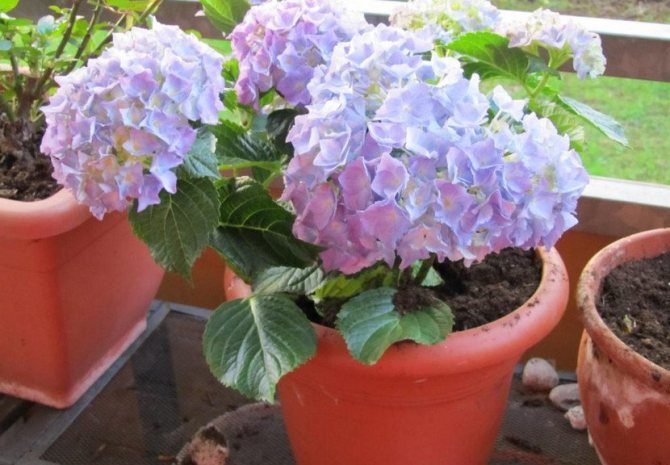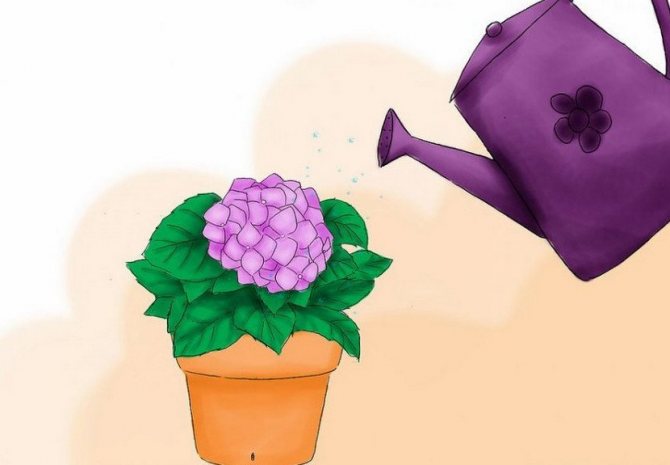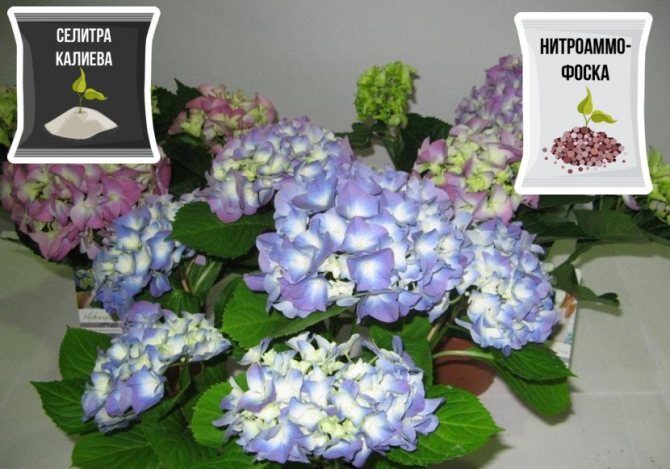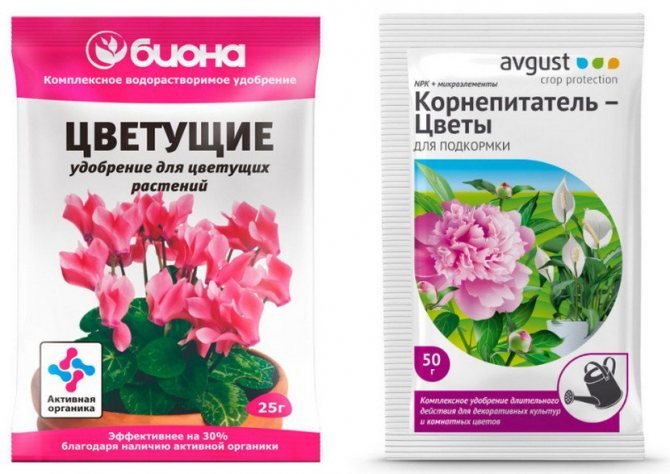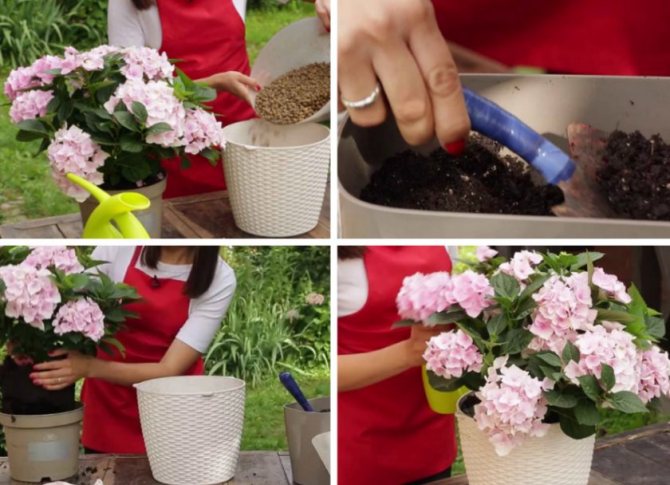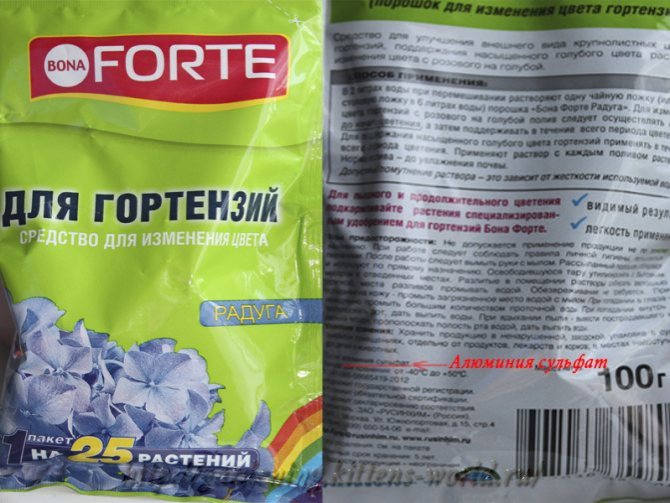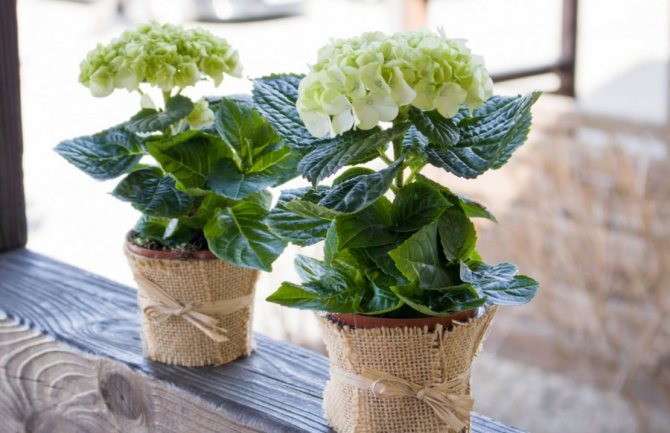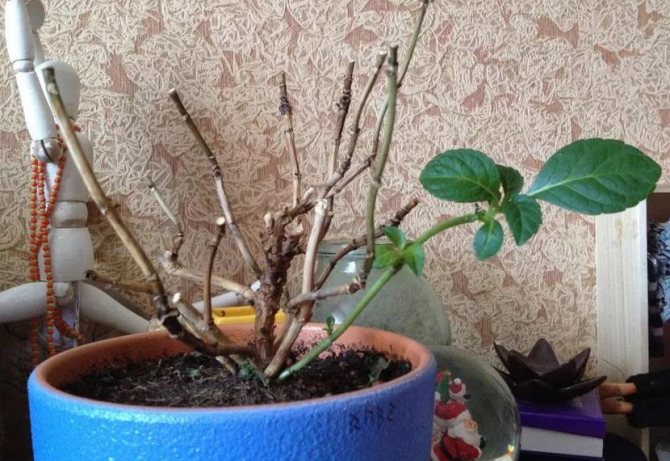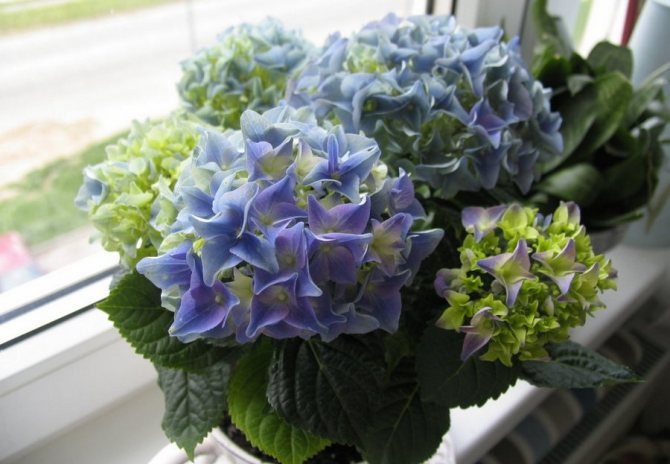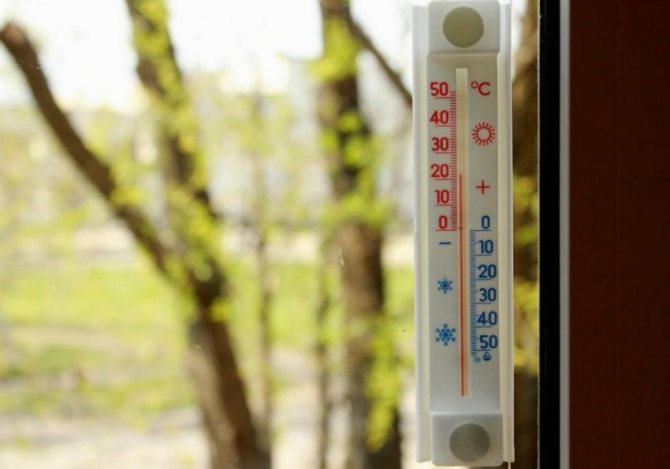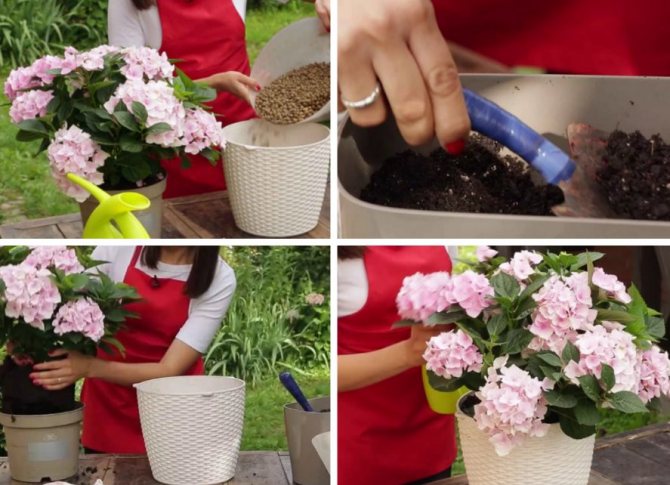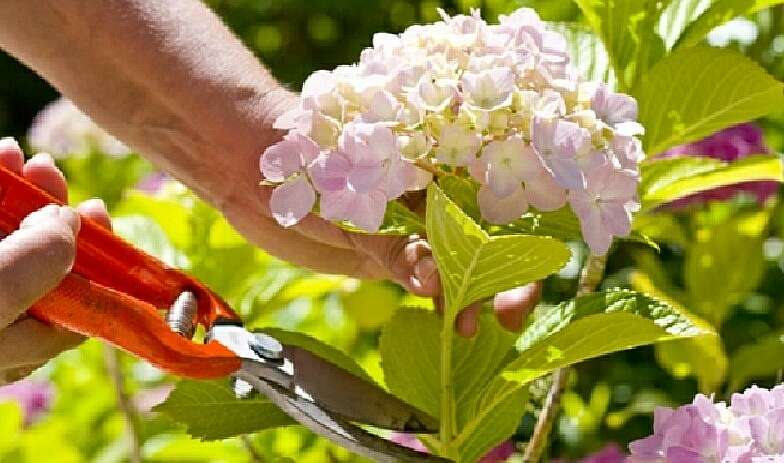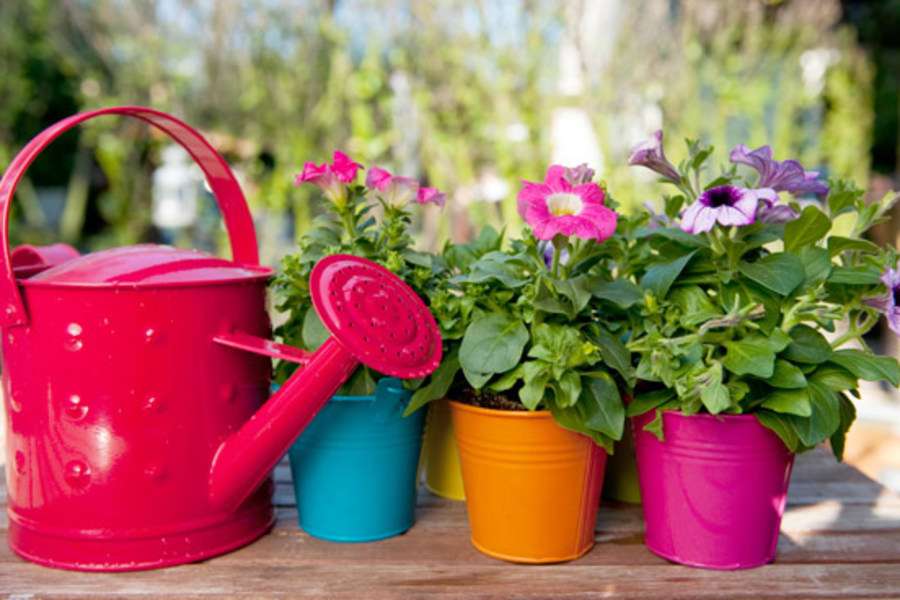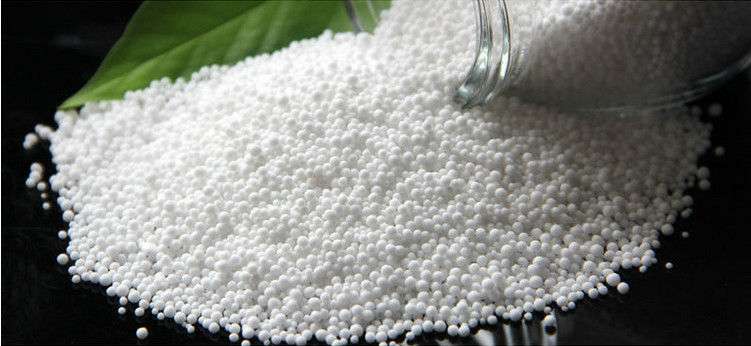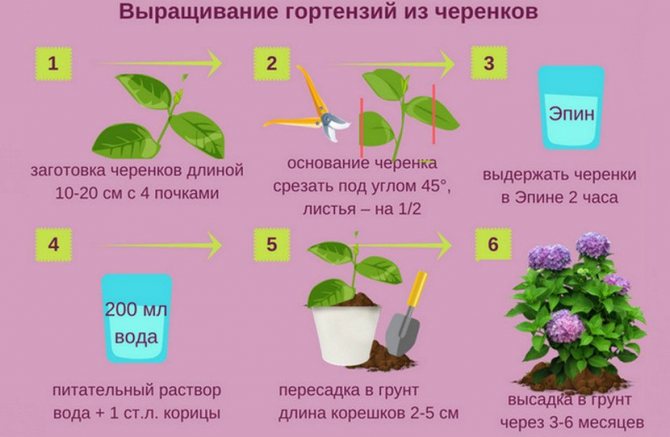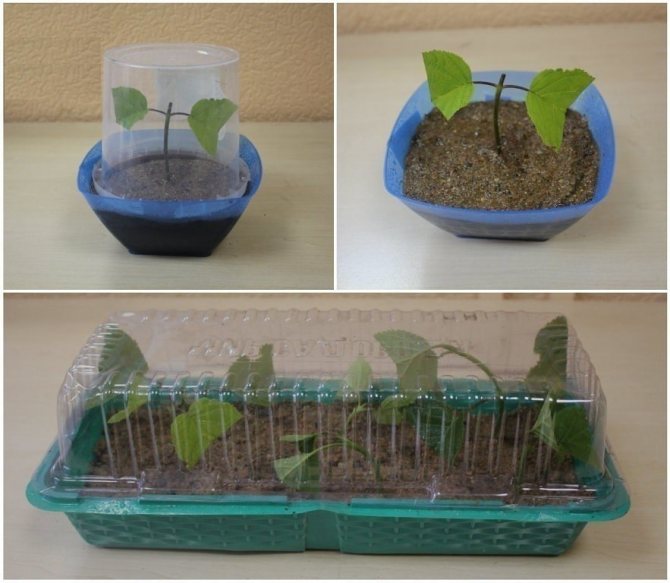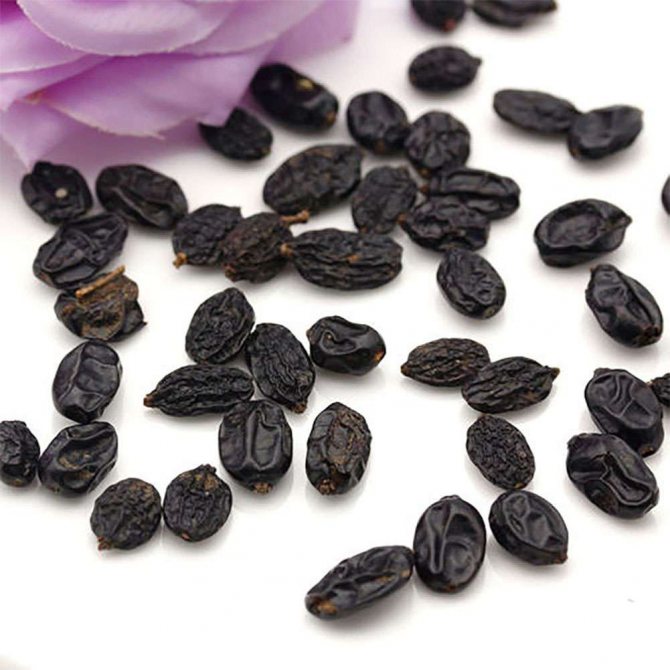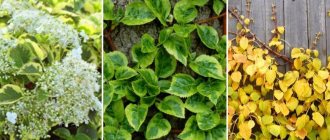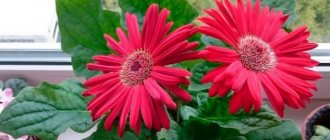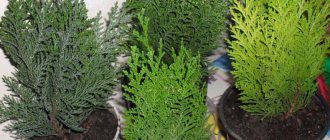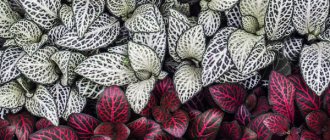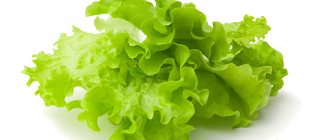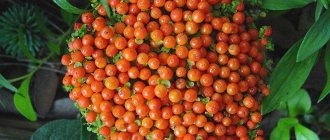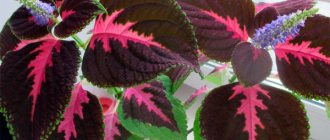Types and varieties of room hydrangea
Hydrangea is a plant whose height reaches one and a half meters. Belongs to the type of dwarf shrubs. Has spreading leaves. They have small notches along the very edge. Differs in very large inflorescences that reach up to 30 cm in length.
The varieties have been bred to create a large palette of colors. Consider the most common for home floriculture.
- Tree-like. A shrub with a height of 3 meters. The leaves are large, fleshy. Bright green hue. Flowers form a spherical sphere and reach a diameter of 25 cm. Flowers, most often, are painted in a milky or beige shade. One of the most unpretentious varieties.
- Large-leaved. The length reaches 2 meters. Suitable for both home cultivation and greenhouse cultivation. The leaves are large enough. The shoots are always light green. The variety is resistant to cold weather, so even in the winter season it feels great on a cold window.
- Paniculata. It looks like a large, spreading shrub or small tree. The height reaches 6 meters. The leaves are elongated. And the shoots turn brown with age. The plant is resistant to cold weather. The inflorescences gradually form a small pyramid. They have shades from milky to blue. By autumn, the flowers acquire a reddish or even brown tint.
Flowers also differ in color, which is inherent in them during flowering. There are varieties:
- red sensation;
- Еarly Blue;
- Europe;
- star;
- linear and so on.
However, the color of the inflorescences is influenced not only by the variety, but also by the composition of the soil. For example, if it is acidic, then a blue tint appears in the flowers. If more alkaline, then a pink or red pigment. If the soil is neutral, then you will get boiling white flowers with milky blotches.
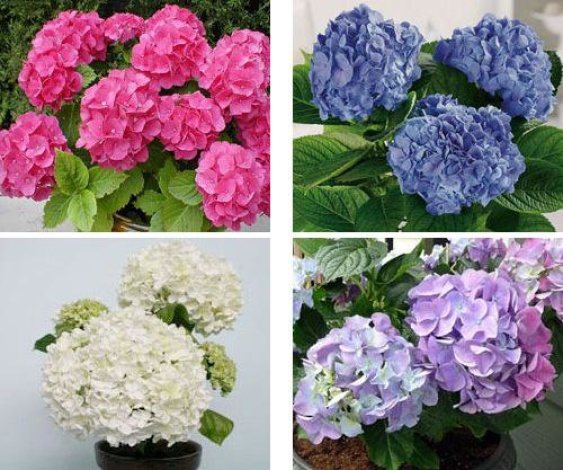
Most Popular
Over the years of working with hydrangea, breeders have bred many varieties suitable for home keeping... Their main task was to reduce the size of the flower and preserve its lush inflorescences.
Popular types include:
- Ramars mars... A compact variety with bright blue inflorescences up to 20 cm in diameter. The soil must be acidic for successful growth and flowering. Constant pruning is required.
- Compacta... It produces lush foliage and blooms in white or pink. Looks beautiful at a height of no more than 50 cm. The formation of the crown by pruning helps to preserve decorativeness.
- Soeur therese... Snow-white variety with perfect spherical inflorescences. The height does not exceed 40 cm. Flowering begins in early summer.
- Prima... Low (up to 25 cm) variety with pink and red flowers. The shape of the inflorescences is a flattened ball.
- Europe... Against the background of dark emerald foliage, a delicate lilac-blue palette of inflorescences that form lush (up to 18 cm) balls looks great. It reaches a height of 50 cm.
- Madame E. Mouillere... Variety with glossy leaves and white inflorescences. The crown has the shape of a ball, which gives the plant a special decorative effect.
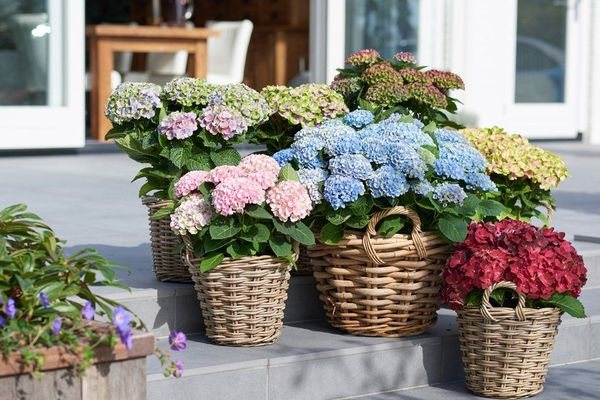

By March 8 and on Easter, large-leaved hydrangea is sold in stores, which does not belong to indoor species: it is specially grown for sale. A faded bush, as a rule, is simply thrown away.
How to choose a hydrangea in the store
It is believed that it is better to purchase a flower in specialized stores.
The first step is to look at the stem.It should be dense, elastic, and have an expensive green color. There should be no brown or yellow formations on the leaves. They should be juicy and bright green. If hydrangea leaves are lethargic, dry at the edges, or have white or yellow spots on them, you should refuse to buy.
Take a close look at the flower hat. It should be dense, saturated with bright colors. If the cap is pale, and the flowers begin to fall with a light touch, it means that the plants have received less nutrients.
There is one general rule to apply when choosing a flower - it should look healthy, nourished and hydrated.
Care and transplant after purchase
It is not recommended to transplant the hydrangea immediately after purchase. The plant must get used to new conditions. Give her 2 weeks to 1 month to adapt.
In the future, the transplant procedure should be carried out at least once every 3-4 years.
If you transplant into larger pots annually, you can achieve the most lush bloom a hydrangea can produce. The roots of the plant grow in breadth, so the volume of the pot must match.
Choose a pot that is slightly larger than the diameter of the one in which you purchased the flower.
While the plant is adapting, you can gradually acquire the ingredients for the substrate. You will need 1 part of sand, two parts of peat, two parts of deciduous land, and 4 parts of turf land. All this is mixed and poured into the pot.
Do not forget that in the early stages of life in a new hydrangea room, additional care in the form of feeding will be required. It is better to buy a mineral fertilizer designed specifically for indoor flowering plants. You can buy it in a specialized store. It is important not to overdo it here, so dilute the dressing in accordance with the instructions and water the flower in the amount indicated on the package.
Hydrangea does not like direct sunlight, but loves warmth and diffused light. Therefore, it is better to place it on a shaded window.
As soon as the hydrangea gets stronger, you can take care of it and carry out a transplant.
At first after the purchase, namely, the first two weeks, it is better not to pour the plant. It is necessary to moisten the soil as it dries. But it is highly recommended to spray leaves and flowers from a spray bottle. This procedure needs to be done every two days.
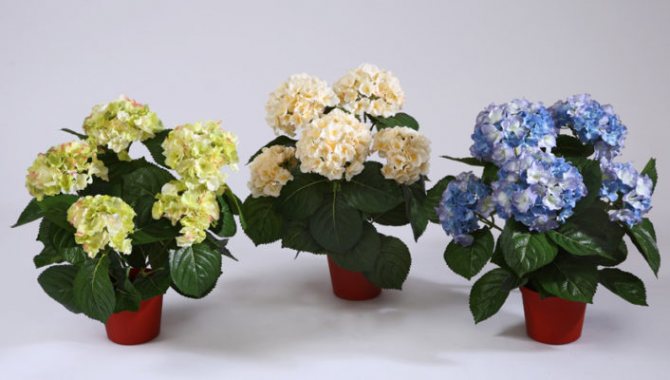

What to do with potted hydrangea in spring?
Around the end of March, the overwintered hydrangea must be removed from the basement, spilled with warm water and fed. If necessary, the bush can be transplanted into a more spacious flowerpot, and after watering, it must be mulched in order to delay the evaporation of moisture. Before "moving" to the street, the pot needs to find a bright spot in the house.
It is possible to take out a hydrangea into the garden not earlier than the end of April, or even in May, but at first, at night, take it into the house or cover it with agrofibre so that the bush does not suffer from recurrent frosts.
Particular attention should be paid to the location of the hydrangea in the garden, because it does not like too bright lighting, from which the flowers fade. As long as there are no buds, the east side is best. And during flowering, it is worth completely removing the bush under a canopy so that the sun hits it only in the evening.
Hydrangea care at home
Lighting for indoor hydrangea
If you choose the right lighting for a flower, then it will delight you with its color for a long time.
It is important to choose the right place here. This is necessary in order for the colors to be abundant. However, so that direct sunlight does not fall on the leaves and flowers of the plant. Therefore, you need to place the flower at a distance of about 3-4 m from the window. In this case, the plant will feel perfect.
Temperature for hydrangea
In terms of temperature, the plant is capricious.Ideal room conditions are between 18 and 23 ° C. It is perfect for hydrangeas. The plant should not be exposed to drafts, as it may die.
During the winter season, this flower can be placed in a room where the temperature is at 10 ° C. Then the hydrangea will go into a slight hibernation and will accumulate strength until the new summer season.
Don't forget about watering. Water used to irrigate the land must be at room temperature. Under no circumstances should you use water from the refrigerator.
Watering hydrangea
In caring for hydrangea in terms of watering, there must be regularity.
- Hydrangea is very fond of fresh water. It can be attributed to moisture-loving plants.
- For irrigation, settled water is ideal, which has room temperature.
- The hotter it is outside the window in the room, the more often you need to irrigate the ground. Don't forget to spray the flowers and leaves with a spray bottle. However, you should not be zealous with watering. It needs to be updated as the earth dries up. If poured, it can easily rot a hydrangea.
- If the leaves of the hydrangea have begun to turn yellow, this means that it is lacking in acid. Therefore, sometimes you need to give her a shower with acidic water. To do this, stir 5–8 drops of lemon juice in one liter of water.
Air humidity
Hydrangea loves moisture in the air. Therefore, when the heating season begins and the air is dry, the plant suffers greatly. So don't forget to spray it with a spray bottle.
If you have a humidifier, place the plant pot next to it. It is enough for hydrangeas to spend about half an hour next to a humidifier to store moisture for several days in advance.
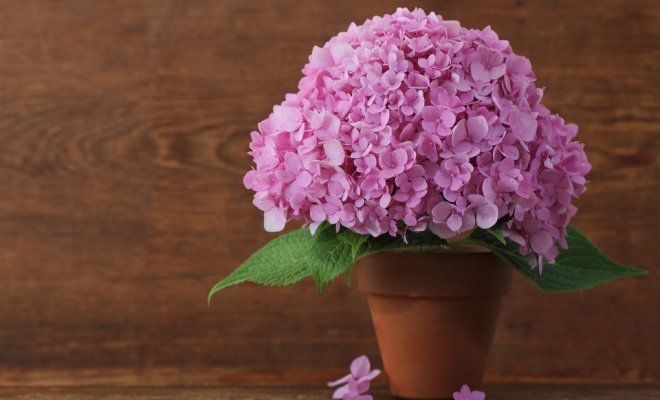

Watering
This question flows smoothly from the previous one. Growing large-leaved hydrangeas in pots is surprisingly fun but challenging. In order for the plant to feel great, a number of conditions must be observed. Hydrangea, both garden and potted, needs abundant watering. The soil in the pot should always be slightly damp. In warm weather, you will have to do this every day. But in winter, the frequency is noticeably reduced, because the plant goes to rest. During this period, the earth is moistened in small portions, each time waiting for light drying.
In summer, you can choose between two watering methods:
- At the root.
- Moistening by immersing the pot in water.
Each of them has the right to life. Focus on what will be more convenient for you. Because of the plant's love for abundant watering, the pot must have excellent drainage with a height of at least 2 cm.Otherwise, the water may stagnate or sour.
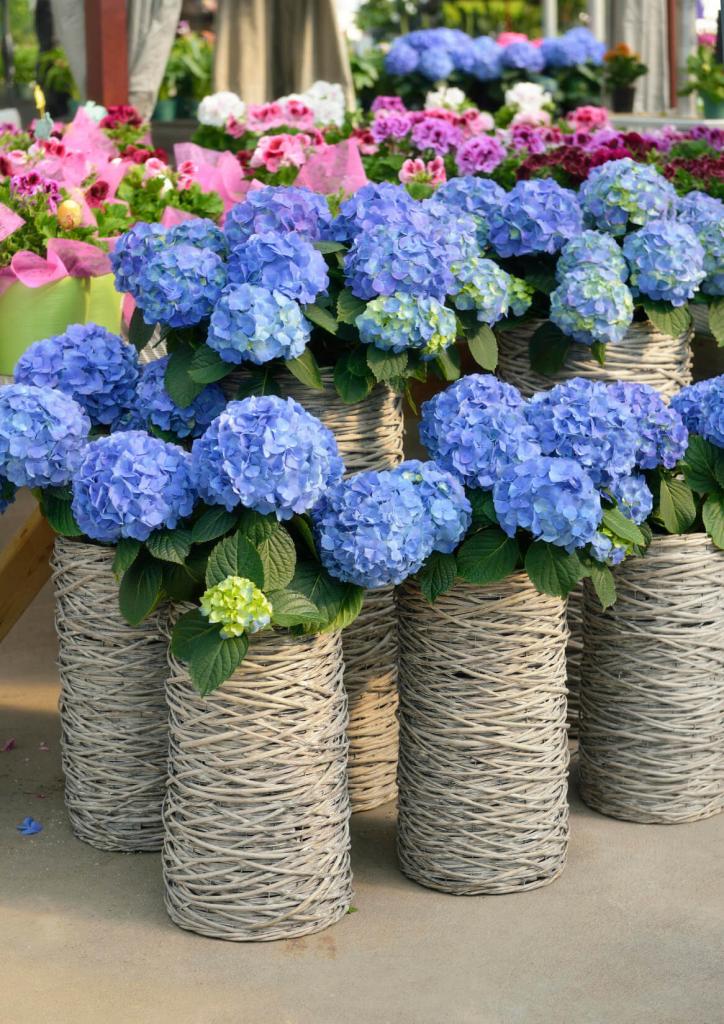

Feeding
In the spring-summer period, Hydrangea enters the stage of activity. At this stage, for enhanced growth, she will need an additional amount of useful mineral and organic substances. Therefore, it is at this stage that organic fertilizer should be applied.
Unfortunately, if you neglect this kind of care, the plant will stop blooming and develop further.
Watering several times a week, you need to add a few drops of potassium permanganate to the water.
Winter care does not involve the use of top dressing.
Gardeners say that gibberellin solution has success in caring for hydrangeas. Approximately 0.1 g per 1 liter of water is used. Due to its composition, hydrangea quickly passes into a state of flowering.
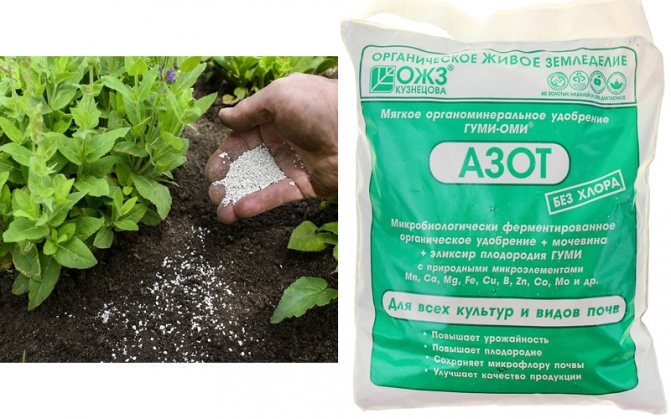

Pruning
The pruning procedure is imperative in order to maintain the attractive appearance of the plant. This procedure will require a well-sharpened knife or pruner. The cut should be sharp and even.
During pruning, weak leaves and stems that have begun to dry or rot are removed. It is also necessary to trim the top of the plant in order to form a more lush crown.
It is ideal to prune twice a year.This is in the fall, when the flowering period has passed, you need to remove the weakened leaves and in the spring, when you need to remove the weakened shoots.
During the flowering period, the pruning procedure stops. It begins when the first faded flowers or leaves appear. It is them that need to be removed so that the plants do not rot.


Dormant period
The dormant period for hydrangea begins in the cold season. As a rule, in autumn frosts. Plants hibernate, consume less moisture and stop blooming. To give the plant to gain strength before the next season, it must be placed in a room with a temperature of no more than 10 degrees. Do not forget about watering as the earth dries up.
Hydrangea will resume its vitality in late March - early April, when the sun begins to actively warm up.
Reproduction
Hydrangea propagation can be done in various ways. Some are more, some are less effective. Let's consider what are the nuances of each method.
Propagation by cuttings
Propagation by cuttings is the easiest way. The most favorable time for this is January or February.
Take a closer look at the root shoots. Cut the cuttings so that there are no more than three nodes on the branch. They should be about 8 cm long. Remove all leaves from the bottom of the cut root. The upper leaves should be cut exactly in half.
The cut of the bottom side must be treated with a special root stimulant, which is sold in specialized stores.
Cuttings should be planted in a specially prepared substrate, which consists of peat and sand. Provide maximum moisture to promote early root formation. The ideal temperature is up to 20 degrees.
Some housewives advise covering the cuttings with special glass jars. However, once a day for a few hours, you need to leave the plant to air, removing the glass protection. The plant needs constant moisture, so the soil needs to be watered and sprayed with a spray bottle.
Already after one month, the cuttings can be planted over the prepared peas.
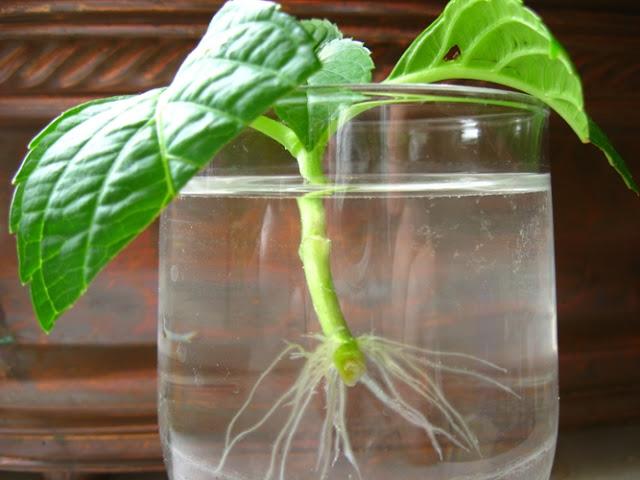

Reproduction by dividing the bush
Dividing a bush is another common method. However, you need to act with caution so as not to spoil the entire bush.
Shoots are evenly shortened. The bush is divided into several parts, gently freeing the roots. Parts of the plant must be distributed in different pots in a specially prepared adversary and watered.
You can apply a mulching procedure, which is designed to root the plants faster. It is better to carry out this procedure in the spring so that by the fall the plant already feels comfortable in the pot.
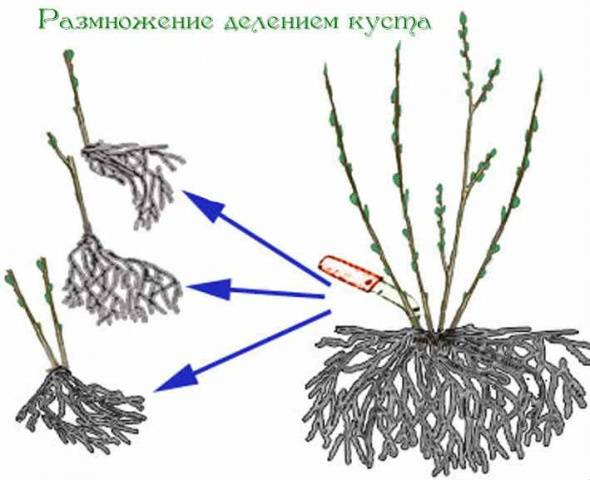

Seed propagation
When growing seeds, the procedure must be carried out already in February.
- Prepare the soil, which consists of turf and humus.
- In addition to it, you can add impurities of peat or sand.
- Purchase special containers that are designed for growing.
- Sprinkle hydrangea seeds on top. They do not need to be buried in the ground.
- Water the ground well.
- Then you need to close the container with cling film or glass. Every day you need to ventilate the crops and moisten them with a spray bottle. Remember that the soil should be predominantly moist, but not wet.
- As soon as the first shoots appear, the cling film can be removed.
When two leaves appear, they need to dive into the container.
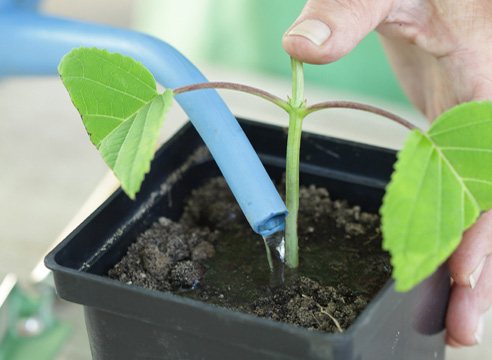

Reproduction by layering
This type of reproduction is best done in March. It is used for plants that grow outdoors. However, it can also be used for home flowers.
- The soil around is dug up and compared.
- Small grooves are made to a depth of 2 cm. Approximately one shoot is placed in them. By the way, the shoots need to be cut off from the bottom of the bush.
- They are laid parallel to the ground and covered with earth.
- Then you need to constantly spray this place from the spray bottle in order to carry out proportionate humidification.
- As soon as the roots appear, you need to make a constriction of soft wire. It is carried out in three turns.
- The more the wire is pressed in, the faster the roots will emerge from this place.
By the end of summer, several months after the start of reproduction, several young shoots appear on the layer. Once they reach a height of 20 cm, they can be transplanted into a separate pot.
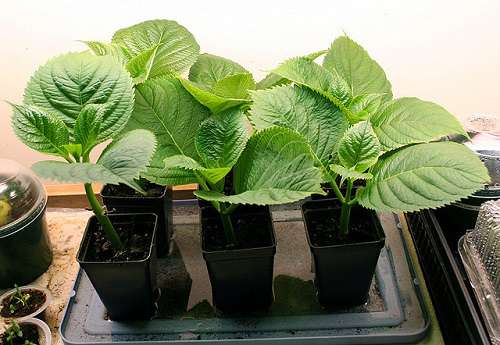

How to properly plant at home
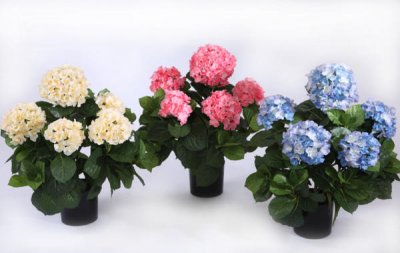

As for the method of planting seeds at home, it is practically not used, unless this is the only way to grow a hydrangea of some very rare variety. Difficult, long.
And here planting by cuttings is very convenient... Cuttings are taken from root shoots. They should have several pairs of leaves - two or three. Flowering shoots are not suitable as planting material (read about the best ways to propagate hydrangeas here).
How to do it step by step:
- a stalk is cut off with a sharp knife (length from 8 to 10 cm),
- treat the stalk with a root-forming stimulant (can be bought at a flower shop),
- the flower pot is filled with two-thirds of the soil mixture,
- plant the stalk in the ground so that it holds tightly in it,
- watered with a weak solution of potassium permanganate (it is not necessary to water too generously so that the roots do not rot),
- shade the plant from the direct rays of the sun (with the exception of winter plantings - in January and February there is no need to shade the cuttings).


What kind of soil is suitable?
There are two possible answers to this question: one prepared with one's own hands or purchased. If you are not a very experienced florist, then it is easier to follow the second path by purchasing a ready-made substrate (Azalea, Begonia or any other on the recommendation of the seller). If you want to do everything yourself, take the sod land (3 parts), leafy ground (3 parts), sand (2 parts), peat (1 part). A mixture based on these proportions will be the right soil for your hydrangea.
REFERENCE: the composition of the soil affects the color of the flower. Blue flowers prefer acidic soil, pink and white flowers prefer low acidity soil.
What kind of pot do you need?
If you define a stalk for permanent residence, then a shipping pot (they usually sell plants in flower shops) will not work. You will need a pot from any dense material (for example, ceramic) with a hole into which excess water will go. Pot diameter - approximately 9 centimeters.
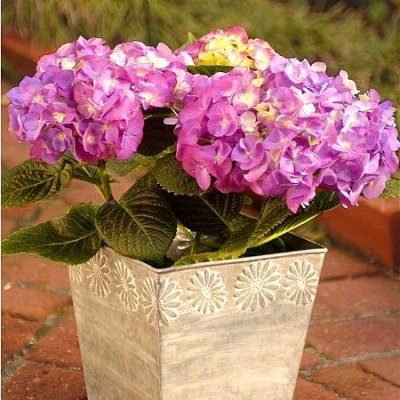

What time of year is it better to plant?
Experts recommend for planting cuttings hydrangeas end of January - February... In this case, in the fall it will be possible to get a bush of three to four shoots. Spring cuttings will produce a less lush, single stem plant.
IMPORTANT: cuttings take root through 2 - 3 weeks after landing. The indoor hydrangea will begin to bloom in the second year, in contrast to the garden hydrangea, the flowering of which will occur earlier (it is just that slightly different technologies are used there).
Diseases and pests
Hydrangea is prone to diseases that form on it with surprising frequency.
- Gray rot. Appears on the leaves if you overdo it with moisture. Reduce watering and make it a rule to treat the flower with a special Bordeaux liquid.
- Spider mite. When the air is dry, on the contrary, a spider mite or aphid appears on the plant. To destroy this attack, you need to water the hydrangea with soapy water or a special product from the store.
- Powdery mildew is false. Appears in high humidity. It is eliminated through the use of drugs that contain copper.
- Nematode. A terrible dream for a hydrangea. If the plant is affected by more than 50%, then, unfortunately, it can no longer be saved and will have to be thrown away.
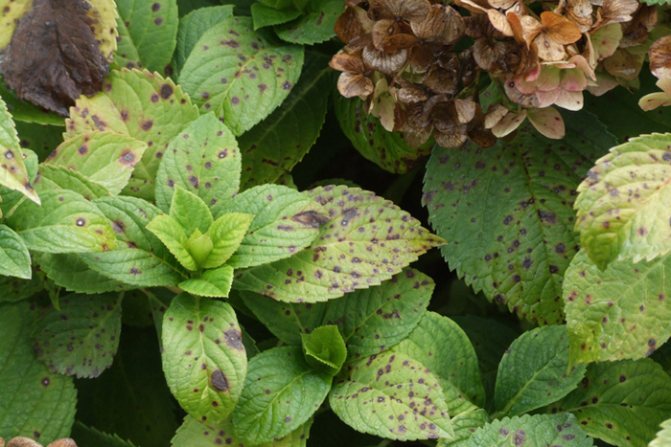

Air humidity
This is an important indicator both for the person himself and for his green pets. It is very good if you have acquired a humidifier. Hydrangea is moisture-loving. This applies not only to watering, but also to the moisture contained in the air. If you notice that the tips of the leaves curl and dry out, then it's time to think about a natural moisturizer or a special device that regularly micro-sprays water.
This is optional, but desirable. Growing hydrangeas in pots has many subtleties and if you want to see your plant lush and in bloom, then you must adhere to this rule. As already mentioned, at low humidity, the tips of the leaves begin to dry out. The plant's immunity decreases and it becomes an easy prey for pests, for example, a spider mite.
Hydrangea responds well to regular spraying. Only during budding and flowering should you try not to get on the plant. Otherwise, water stains remain, which spoils the general appearance of the plant. During this period, you can choose a different method of air humidification. For example, place a pot on a tray filled with pebbles and add water to it. The second option is to place an aquarium nearby. And of course, for all procedures you need to use soft, settled water.
Preparing for winter
Before sending the hydrangea into hibernation, it must be prepared on the eve of the onset of cold weather.
The plant cannot hibernate in the conditions of the Russian winter without appropriate insulation. This also applies to indoor hydrangeas. Do not place the hydrangea on an open balcony where the temperature is below 0 degrees. The ideal temperature for wintering hydrangeas is + 10 ° C.
Before preparing the hydrangea for winter, you need to do the appropriate pruning. For this, faded flowers, dry or, conversely, too sluggish leaves are removed. If there are individual shoots that have grown in length, but are very dry, or vice versa, they show signs of rot, they also need to be cut off.
After the procedure has been completed, the plant must be brought to a new irrigation regime. Now you need to water less often so that the hydrangea does not rot for winter.
Prepare the room for the flower. The temperature in it should be within 8-15 degrees, not higher or lower. Place the plant in this area and make sure it is not attacked by drafts.
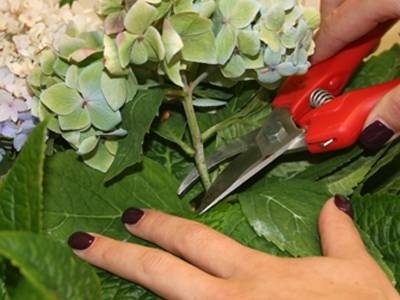

Change the color of the hydrangea
Not all hydrangea owners are happy with its color. You may not have known, but it is easy to change it.
- Make the soil more alkaline. Then, along with a blue or white tint, bright pink flowers will appear.
- If you make the soil more acidic or regularly water the plants with water with the addition of a few drops of lemon juice, you can achieve a blue tint.
- If the soil is in a normal state, and the plant is regularly watered with water with the addition of a small amount of potassium permanganate, then the hydrangea will acquire a white tint.
Description
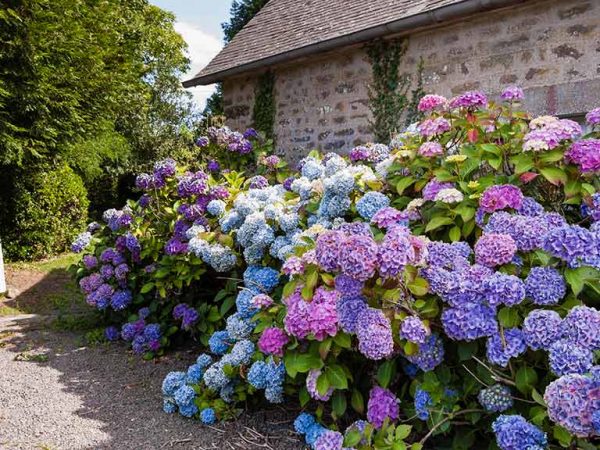

Bright hydrangea is a decoration of any garden.
Hydrangea, also called hydrangea, belongs to the genus of the same name, numbering more than 70 varieties. It is noteworthy that the required keeping conditions for different varieties of hydrangeas can vary significantly. The homeland of the plant is South and East Asia, North and South America. Hydrangea can often be found in China and Japan, some species grow in the Far East in Russia.
Among the hydrangeas, there are shrubs and miniature trees. They all have large flowers with four colored sepals. Most varieties of hydrangeas change the shade of flowers depending on the hydrogen composition of the soil. In an acidic environment, the plant blooms with blue flowers, in a neutral environment - white or cream, in an alkaline environment - pink or lilac.
Difficulties in growing hydrangeas
Leaves dry
If the hydrangea leaves dry, it means that it lacks moisture.Give preference to watering with a spray bottle, which should be done daily. Also, do not forget about airing the room.
Watering should be carried out as the land dries up. Run a humidifier near the hydrangea for a few hours.
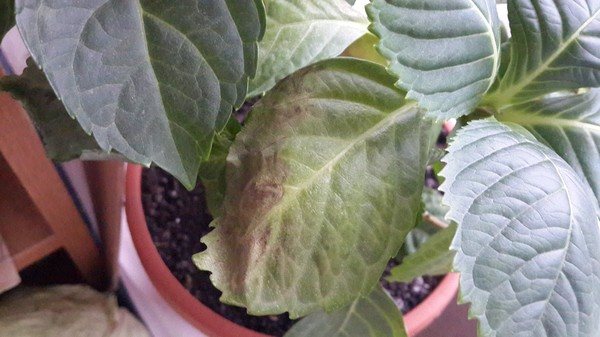

Leaves fall
If leaves fall, then, unfortunately, this is also evidence of improper care. Fall from dryness indicates a lack of moisture and the proper amount of nutrients.
If the leaves just wither and fall, it is most likely that the hydrangea lacks sunlight and warmth. Therefore, raise the room temperature to the desired level.


What to do if the hydrangea wilted
If the hydrangea has wilted by 40%, you can try to reanimate it. To do this, it is watered with water, in the composition with potassium permanganate. Additionally, copper sulfate and other top dressing are bred, which are poured into the soil.
If it was not possible to rehabilitate the hydrangea, you should say goodbye to it. And the mistress needs to analyze what caused the plant to wither so quickly.


Hydrangea does not bloom, what to do
The plant will bloom if the following conditions are met.
- When the rest period ended.
- Was properly prepared for winter.
- Receives the proper amount of nutrition and feeding.
- All diseases of the flower were removed.
If you missed any of these points, then, most likely, this is why the hydrangea does not bloom. However, the reason may lie in completely different factors. For example, the roots were damaged during transplantation. The plant directs all forces to restore their integral structure and not wither. Therefore, flowering is temporarily postponed.
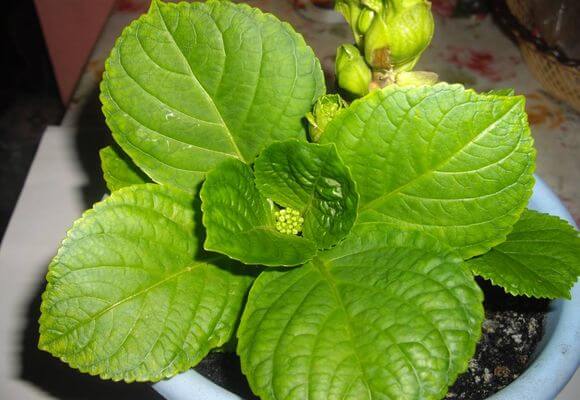

Many call hydrangea a capricious plant. Indeed, to care for it, you need to very correctly select the necessary standards for temperature and humidity indicators. However, a hostess who is not afraid to mess with hydrangea and is ready to care for it both in summer and winter can decorate her house with an incredible color that will delight you all spring, summer and autumn.
Did you like the article? Was she helpful?

